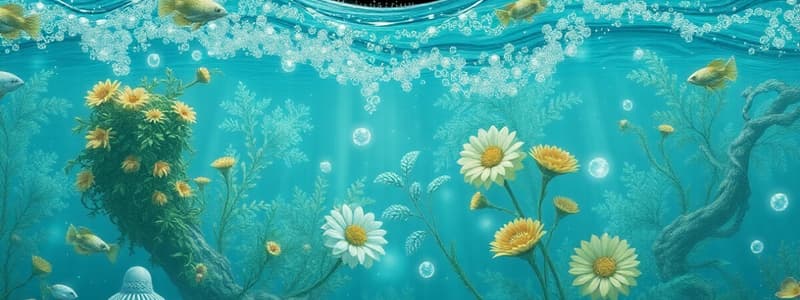Podcast
Questions and Answers
What is the main source of oxygen for aquatic life?
What is the main source of oxygen for aquatic life?
- Atmospheric air (correct)
- Photosynthesis by microorganisms (correct)
- Chemical reactions in water
- Dissolved carbon dioxide
How does temperature affect the solubility of gases in water?
How does temperature affect the solubility of gases in water?
- Increases solubility of both gases
- Decreases solubility of both gases (correct)
- Decreases solubility of carbon dioxide at a greater rate (correct)
- Increases solubility of oxygen only
Why is the solubility of gases lower in salty ocean water compared to fresh water?
Why is the solubility of gases lower in salty ocean water compared to fresh water?
- Higher concentrations of oxygen in the ocean
- Salts interfere with gas molecules (correct)
- Different atmospheric pressure
- Variation in temperature
Which effect does high dissolved oxygen have on aquatic organisms?
Which effect does high dissolved oxygen have on aquatic organisms?
What role does oceanic movement play in oxygen levels in water?
What role does oceanic movement play in oxygen levels in water?
What is the consequence of low dissolved oxygen levels in an aquatic ecosystem?
What is the consequence of low dissolved oxygen levels in an aquatic ecosystem?
What is the relationship between the concentration of oxygen gas in air and its solubility in water?
What is the relationship between the concentration of oxygen gas in air and its solubility in water?
Which factor primarily helps maintain the balance of an aquatic ecosystem?
Which factor primarily helps maintain the balance of an aquatic ecosystem?
What effect does low concentrations of CO2 have on the pH of water?
What effect does low concentrations of CO2 have on the pH of water?
How do deep-sea fish adapt to the high-pressure environment?
How do deep-sea fish adapt to the high-pressure environment?
What is a physiological adaptation seen in Electric Eels for oxygen extraction?
What is a physiological adaptation seen in Electric Eels for oxygen extraction?
What is the main process described in relation to osmosis?
What is the main process described in relation to osmosis?
What characterizes the blood pressure adaptation in deep-sea fish?
What characterizes the blood pressure adaptation in deep-sea fish?
Why is the adaptation of slowing down metabolism beneficial for Electric Eels?
Why is the adaptation of slowing down metabolism beneficial for Electric Eels?
What creates osmotic pressure in a solution?
What creates osmotic pressure in a solution?
How do physiological adaptations function in aquatic organisms?
How do physiological adaptations function in aquatic organisms?
What is the primary process observed when the sugar solution draws water from the beaker?
What is the primary process observed when the sugar solution draws water from the beaker?
How do unicellular organisms like amoeba adapt to low osmotic pressure in freshwater?
How do unicellular organisms like amoeba adapt to low osmotic pressure in freshwater?
What mechanism do multicellular organisms, such as fish, use to eliminate excess water?
What mechanism do multicellular organisms, such as fish, use to eliminate excess water?
How do saltwater fish cope with osmotic loss of water?
How do saltwater fish cope with osmotic loss of water?
What role does urea play in sharks' adaptation to their environment?
What role does urea play in sharks' adaptation to their environment?
What happens to freshwater organisms if they cannot adapt to low osmotic pressure?
What happens to freshwater organisms if they cannot adapt to low osmotic pressure?
Which of the following is NOT a method used by freshwater organisms to manage water intake?
Which of the following is NOT a method used by freshwater organisms to manage water intake?
Which statement best describes the physiological adaptations of sharks?
Which statement best describes the physiological adaptations of sharks?
What is the main source of carbon dioxide in aquatic environments?
What is the main source of carbon dioxide in aquatic environments?
How does increased carbon dioxide in water affect the pH value?
How does increased carbon dioxide in water affect the pH value?
What adverse effect can high levels of carbon dioxide have on aquatic organisms?
What adverse effect can high levels of carbon dioxide have on aquatic organisms?
What is a consequence of carbon dioxide deficiency in water for aquatic plants?
What is a consequence of carbon dioxide deficiency in water for aquatic plants?
What is one of the negative effects of carbon dioxide on marine organisms like corals and mollusks?
What is one of the negative effects of carbon dioxide on marine organisms like corals and mollusks?
How does a change in carbon dioxide levels in water affect food chains?
How does a change in carbon dioxide levels in water affect food chains?
Which of the following best describes the process of acidification in aquatic systems due to increased CO2?
Which of the following best describes the process of acidification in aquatic systems due to increased CO2?
What role do marine organisms play in the carbon dioxide cycle in aquatic environments?
What role do marine organisms play in the carbon dioxide cycle in aquatic environments?
What physiological adaptation do sharks use to regulate their osmotic pressure?
What physiological adaptation do sharks use to regulate their osmotic pressure?
What term describes the process that allows salmon to transition from freshwater to saltwater?
What term describes the process that allows salmon to transition from freshwater to saltwater?
Which adaptation helps fish in the deep ocean see in low-light conditions?
Which adaptation helps fish in the deep ocean see in low-light conditions?
How do the circulatory and respiratory systems of salmon adapt during their life cycle?
How do the circulatory and respiratory systems of salmon adapt during their life cycle?
What structural adaptation do bony fish possess that aids in buoyancy?
What structural adaptation do bony fish possess that aids in buoyancy?
What behavior is exhibited by some fish to survive changing environmental conditions?
What behavior is exhibited by some fish to survive changing environmental conditions?
What characteristic of icefish helps them endure the deep-sea environment?
What characteristic of icefish helps them endure the deep-sea environment?
What common feature reduces water resistance for fish as they move?
What common feature reduces water resistance for fish as they move?
Study Notes
Oxygen and carbon dioxide in aquatic environments
- Oxygen and carbon dioxide are naturally present in water, supporting aquatic life such as plants, fish, and microorganisms.
- The main source of oxygen in water is the atmosphere.
- Phytoplankton, algae, and aquatic plants also contribute to oxygen production through photosynthesis.
- Waves and water currents in oceans increase oxygen solubility.
- Carbon dioxide is more soluble in water than oxygen, but its concentration in the atmosphere is much lower.
- The solubility of both gases is lower in salty water than in freshwater.
- Increasing temperature decreases the solubility of both oxygen and carbon dioxide, but the effect is greater on carbon dioxide.
Biological adaptations of aquatic organisms
- Aquatic organisms have developed physiological, behavioral, and structural adaptations for survival.
- Physiological adaptations involve changes in biological functions.
- Deep-sea fish have adapted to low oxygen levels and high pressure.
- Electric eels have large gills and slow metabolism to survive in oxygen-deprived deep waters.
- Osmosis is the movement of water from a dilute to a concentrated solution across a semipermeable membrane.
- Osmotic pressure drives this movement, determined by the difference in solute concentration.
- Freshwater organisms have adaptations to prevent water intake due to lower osmotic pressure compared to their bodies.
- Unicellular organisms use contractile vacuoles to expel excess water.
- Multicellular fish eliminate excess water through dilute urine produced by their kidneys.
- Saltwater fish drink seawater to compensate for water loss and excrete excess salts through gills and kidneys.
- Sharks maintain water balance using urea concentration in their blood, similar to the osmotic pressure of seawater.
- Behavioral adaptations involve actions or behaviors that help organisms survive.
- Fish migration between freshwater and saltwater is a common behavioral adaptation.
- Salmon migrate to reproduce, adapting to different environments through physiological changes.
- Structural adaptations involve physical changes that enhance survival.
- Deep-sea fish have large eyes for visibility in darkness and compressed bodies to withstand high pressure.
- Icefish, a compressed deep-sea fish, lives in cold southern oceans.
- Fish adaptations include a streamlined body for reduced water resistance, gills for oxygen extraction, scales and mucus for waterproofing, fins for movement, and swim bladders for buoyancy.
Studying That Suits You
Use AI to generate personalized quizzes and flashcards to suit your learning preferences.
Related Documents
Description
This quiz explores the roles of oxygen and carbon dioxide in aquatic ecosystems, highlighting their sources, solubility, and effects on aquatic life. It also delves into the biological adaptations of aquatic organisms for survival in varying conditions. Test your knowledge on these essential environmental concepts!





